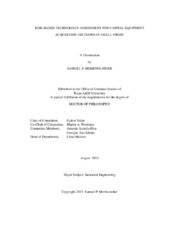Risk-Based Technology Assessment for Capital Equipment Acquisition Decisions in Small Firms
Abstract
Companies and organizations must make decisions concerning capital budgeting. Capital budgeting is a decision-making process that determines whether a firm should purchase equipment to be used on a long-term basis. The initial investment in the equipment is predicted to be returned through revenue gained by the use of the equipment over its lifetime. However, there is inherent risk associated with these investment decisions. Therefore, potential purchasers must decide whether the risk involved with investing in the equipment is justified.
This dissertation addresses risk-based technology assessment for capital equipment acquisition decisions in small firms. Technology assessment, here, is concerned with understanding the uncertainty associated with assessing the value predicted in the capital budgeting process. When analyzing the risk for a given technology, we assign a probability law to its net present value. Our primary research contribution is providing an analytical framework together with a computational strategy to support capital equipment budgeting in firms where the value of candidate technologies can represent nearly all the firm’s value.
Since small firms typically have limited budgets, spending for technology is always a difficult budgeting decision. The organization’s administration must decide which, if any, among the available technologies will be best for their operation.
The process for acquiring technology in many small firms can be filled with challenges. Most important among them is that capital budgeting is typically a “one-off” decision. These decisions are difficult since the candidate technologies may not have operational data available. Thus, decision makers need some means to predict how the proposed technology (e.g., equipment or machinery) will be used. Hence, firms should follow techniques and procedures based on appropriate normative principles and well-established theory. Senior company executives and/or governance boards are often authorized to approve capital equipment purchases. However, these company leaders may not have adequate expertise in the operations of candidate technologies or may lack the understanding necessary to determine how new technologies may impact other company operations. Appropriate financial evaluation measures and selection criteria that incorporate risk are critical to making sound, quantitative acquisition decisions.
The research reported here offers an analytical framework for comparing different technology alternatives in capital budgeting decisions. Comparison is based on the expected net present value and the risk (i.e., probability law on net present value) associated with each decision alternative. To this end, the operational characteristics of each technology alternative are connected to their potential revenue and cost streams. The framework is embedded within a computational architecture that can be customized to account for operations and technologies in specific application scenarios.
One major barrier addressed by this research is overcoming the fact that new technologies typically have no historical operational data. Therefore, characterizing the uncertainty of operations (e.g., distribution of the equipment lifetime) can be very difficult. Discrete- event simulation is used to generate potential revenue and cost estimates.
We demonstrate the tractability and practicality of the analytical framework and computational architecture via a healthcare technology assessment decision. Data extracted from a published journal article detailing a hospital’s technology assessment decision are used to find the risk of the medical technology using the computational architecture developed. Widely-available, no-cost software tools are employed. Results of the health care example suggest that the financial analysis in the original technology assessment was in- adequate and simplistic. Small firms may find this research particularly beneficial because potential investments can be a significant portion of a small firm’s value.
Citation
Merriweather, Samuel P. (2013). Risk-Based Technology Assessment for Capital Equipment Acquisition Decisions in Small Firms. Doctoral dissertation, Texas A & M University. Available electronically from https : / /hdl .handle .net /1969 .1 /151392.


